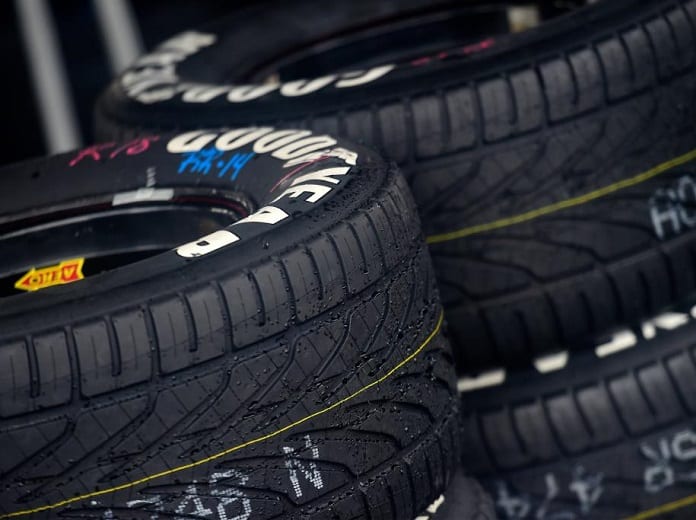MARTINSVILLE, Va. — NASCAR will take a page out of its 1995 playbook for an upcoming Goodyear tire test Thursday at Martinsville Speedway.
That year, after a washout of practice during the NASCAR Cup Series’ September race weekend at the .526-mile paper clip, Terry Labonte turned several laps with a treaded wet-weather tire on his No. 5 Hendrick Motorsports Chevrolet.
Twenty-six years later, Kyle Larson will do the same, also in a No. 5 Chevrolet prepared by Hendrick Motorsports.
Larson will be joined by Roush Fenway Racing’s Chris Buescher at Martinsville for the rain tire test, which looks to determine the feasibility of utilizing the wet-weather rubber in damp conditions.
NASCAR is already in the midst of a two-day Next Gen test at Martinsville this week, where Chevrolet, Ford and Toyota are putting their manufacturer-specific cars to work for the first time in advance of the 2022 debut of the Next Gen platform in Cup Series competition.
However, Thursday’s goal is to explore the potential of using rain tires to return to racing quicker at some of the short tracks on the NASCAR schedule, including Martinsville, during adverse weather conditions.
Should the test prove feasibility, flat tracks up to one mile in length — including Arizona’s Phoenix Raceway and New Hampshire Motor Speedway — could see rain tires in play if conditions warrant.
“I think the overall goal is that anything we can do to speed up the drying process, regardless of the technology, to allow us to get back to racing more quickly is a benefit to the fans,” NASCAR executive vice president and chief racing development officer Steve O’Donnell told NASCAR.com. “We’re always trying to innovate and you saw that with what we’ve done around the track-drying system and that’s worked out well. We’ve always looked at what’s the next iteration.
“If you’ve looked at what the teams have been able to do with more road racing coming into the fold, the idea of short tracks and could we work with Goodyear to find a tire that would allow us to get back to racing sooner under wet-weather conditions came up.”
The first competitive situation where rain tires were used in NASCAR was in 2008 at Circuit Gilles Villeneuve in Canada, when the NASCAR Xfinity Series needed to utilize them during a race.
The NASCAR Cup Series, however, didn’t bring rain tires into the competitive equation until last fall’s playoff race at the Charlotte Motor Speedway ROVAL, where a damp track necessitated a wet start to the event before teams switched toGoodyear slicks at the end of stage one.
“We had a conversation with Goodyear and they’re on board [with this] as well, so I think that’s why the timing just lined up for us of ‘Let’s try to innovate, let’s try this and see what we can learn,’” O’Donnell tipped.
An initial shakedown of the two cars will precede competition officials dampening the track in a controlled situation, monitoring traction levels and gathering feedback from Buescher and Larson to further evaluate the rain tires’ performance.
The tires being tested at Martinsville will have different qualities than the current NASCAR rain tires that are utilized when needed for road course events.
O’Donnell also stressed that rain tires would not be utilized on an oval in any sort of a heavy storm.
“At this point, we’re not talking about if it’s actually raining,” O’Donnell said. “It’s more so, can we get back more quickly than the track being completely dry, which is what we require now. That’s part of the test, looking at where’s the limit, where we would feel comfortable for the drivers. We want this to be safe, so that will be part of this test — talking to the drivers, what are they comfortable with — then obviously talking to Goodyear and (director of racing) Greg Stucker and his team about how they feel and how the tire performs, what if any tweaks we could make to that tire coming out of Martinsville, so there’s a lot that we’re hoping to learn here in terms of grip levels.
“Each track is unique, so this is something we’ll have to look at for multiple venues.”
In an odd coincidence, Thursday’s test falls on April 1, but O’Donnell made it clear that this trial isn’t a joke — and that competition officials are hoping for a positive result.
“It just happens to fall on April Fools’ Day. You can’t make that up,” laughed O’Donnell. “No, this is a real thing and a real test, and we’ll be happy to report back April 2 on how it went.”
Turning back the clocks, Labonte roughly averaged 70 mph on the wet Martinsville surface when he tested the Goodyear rain tires in 1995. What was his reaction?
“The tires felt good,” a quote from Labonte read in the Sept. 27, 1995 edition of National Speed Sport News. “I wouldn’t want to race in the rain just yet, and I wouldn’t want to go any faster than I did.”
By weeks’ end, we’ll find out how Larson and Buescher’s reactions may compare to Labonte’s thoughts.
